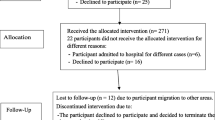Abstract
A random mailed survey was sent to 425 members of a seniors recreation center in Guelph, Ontario for the purpose of identifying the prevalence of nutritional risk, specific nutrition problems, and educational format preferences of these seniors. This needs assessment was used to plan an education initiative called “Action Nutrition.” SCREEN, a 15-item nutritional risk screening instrument, demographic data, participation in current recreation programs, and frequency of visits to the center were included in this survey. The response rate was 62%, average age was 72 years and 59% were female. Respondents attended on average one activity per month, 60% visited the center at least once per month and 79% read the monthly newsletter. 56.7% of respondents were considered to be at nutritional risk using SCREEN and common problems were: significant weight change in 6 months; low intake of fruits and vegetables and milk products; and restriction of the diet due to health reasons. This survey determined that nutrition problems and risk are prevalent among community-living seniors, justifying the development and implementation of educational initiatives in this setting.
Similar content being viewed by others
REFERENCES
Federal, Provincial, and Territorial Advisory Committee on Population Health. Report on the Health of Canadians.Ottawa, ON: Health Canada Communications and Consultation Directorate, 1996.
Burke MA. Implications of an aging society. Can Soc Trends 1991; Spring:6–8.
Codispoti CL, Bartlett BJ. Food and Nutrition for Life: Malnutrition and Older Americans.Washington DC: Us Department of Health and Human Services, Administration on Aging, 1994.
Chandra R, Imbach A, Moore C, Skelton D, Woolcott DM. Nutrition of the elderly. CMAJ 1991; 145:1475–1487.
Gariballa SE, Sinclair AJ. Nutrition, ageing and ill health. Br J Nutr 1998:80:7–23.
McCormack P. Undernutrition in the elderly population living at home in the community: a review of the literature. J Adv Nurs 1997;26:856–863.
Chima CS, Barco K, Dewitt MLA, Maeda M, Teran JC, Mullen KD. Relationship of nutritional status to length of stay, hospital costs, and discharge status of patients hospitalized in the medicine service. J Am Diet Assoc 1997;97:975–978.
MacLellan DL, Van Til LD. Screening for nutritional risk among community-dwelling elderly on Prince Edward Island. Can J Pub Health 1998;89:342–346.
de Groot LC, Beck AM, Schroll M, van Staveren WA. Evaluating the DETERMINE your nutritional health checklist and the Mini Nutritional Assessment as tools to identify nutritional problems in elderly Europeans. Eur J Clin Nutr 1998;52:877–883.
Reuben DB, Greendale GA, Harrison GG. Nutrition screening in older persons. J Amer Ger Soc 1995;43:415–425.
Mac Lellan D. Detecting nutritional risk among Canadian seniors. Can Home Econ J 1998;48: 14–17.
Keller HH, Hedley M, Wong Brownlee S. The development of Seniors in the Community: Risk Evaluation for Eating and Nutrition (SCREEN). Can J Diet Prac Res 2000;61:67–72.
Keller HH, McKenzie JM, Goy R. Construct validation and test-retest reliability of Seniors in the Community: Risk Evaluation for Eating and Nutrition Questionnaire. J Geront: Med Sci 2001; 56A(9):M552–M558.
www.hc-sc.gc.ca/seniors-aines/seniors/english/new/htm. Statistical Snapshot of Canadian Seniors. No. 5 More Women than Men.
Yeung DL, Imbach A. Geriatric nutrition in Canada-a review. J Nutr Elder 1988;7:27–45.
Roebothan BV, Friel JK, Healey L. Diet and drug consumption in a group of elderly residing in rural Newfoundland. Can J Pub Health 1994;85:313–316.
Barber C. Identifying seniors at nutritional risk: Independent seniors. RAPPORT 1996;11:6–7.
National Institute of Nutrition. Enhancing seniors’ nutrition: From awareness to action. Ottawa, On: National Institute of Nutrition, 1998.
Dietitians of Canada, Capital Health Authority, Alberta Council on Aging, Society for the Retired and Semi-Reitred, Edmonton Meals on Wheels. Seniors Community Action for Nutrition Final Report (Project # 6785-09-1998/2450033, Health Canada), 1999.
Author information
Authors and Affiliations
Corresponding author
Rights and permissions
About this article
Cite this article
Keller, H.H., Hedley, M.R. Nutritional Risk Needs Assessment of Community-Living Seniors: Prevalence of Nutrition Problems and Priorities for Action. Journal of Community Health 27, 121–132 (2002). https://doi.org/10.1023/A:1014561217190
Issue Date:
DOI: https://doi.org/10.1023/A:1014561217190




